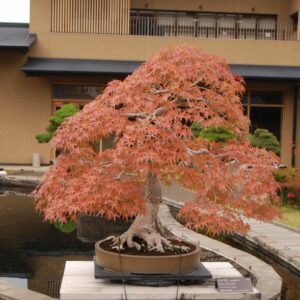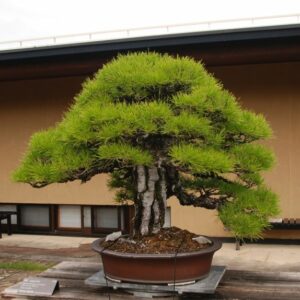The best time to repot bonsai trees is early spring, just before bud break. Repotting in summer and winter is not recommended. You can repot some of the coniferous species in early fall but it is better to wait until next spring if you can.
Introduction to when to repot bonsai
Repotting bonsai trees is essential for their long-term health as it helps to refresh the soil and provide extra room for roots. Deciduous and coniferous bonsai trees have different growth patterns that make them require different repotting considerations.
In this article, I will discuss the best time of year to repot your bonsai trees, focusing on deciduous (flowering/fruiting) and coniferous varieties separately to provide detailed information and guidance for each type.
Please note that the recommendation discussed in this article is based on the growth cycle under temperate climates where there are more or less distinctive seasons.
If you live in a warm climate year-round like in California or Florida or a cooler climate like in Illinois or Washington State, the trees’ growth cycle can be different and thus the timing of repotting can differ.
In any event, repotting just before bud break is the best timing under any climate because trees have time to heal and have a full growing season ahead.
Best time of year to repot deciduous bonsai trees

Here, I will discuss the best time of year to repot deciduous/flowering and fruiting bonsai trees to provide detailed information and guidance.
Please note that I will address these deciduous/flowering and fruiting bonsai species as “deciduous” going forward because most flowering and fruiting bonsai trees are in fact deciduous trees.
Deciduous bonsai tree growth cycle
Like all plants, deciduous bonsai trees have a natural growth cycle that follows the changing seasons. Understanding this growth cycle is crucial for deciding when to repot your bonsai tree and why it is the best time to do so.
In general, the growth cycle of a deciduous bonsai tree can be broken down into four main phases:
- early spring growth,
- spring and summer growth,
- fall preparation for dormancy and
- dormancy.
Early spring growth
As temperatures begin to warm up in the spring, deciduous bonsai trees will start to come out of dormancy and begin to sprout. They use the energy they stored in the previous growing season in their branches and trunk to fuel this growth.
Spring to summer growth
In the warmer spring to summer months, deciduous bonsai trees will continue to grow and develop new foliage and branches. This is also a time when the tree is actively producing energy through photosynthesis.
When the energy they created is not used immediately, the excess will be stored throughout their entire body: in their branches, trunk and roots.
The way the energy is used depends on the distance from the leaves where they produce energy. Nutrients located in leaves or branches are quickly used up, while those in farther branches and trunks are used relatively quickly but not immediately. Nutrients in even more distant roots are reserved for emergencies, like in winter.
Fall preparation for dormancy
As temperatures begin to cool down and days get shorter in fall, deciduous bonsai trees will stop growing and start to prepare for dormancy by making winter buds for the following spring while redirecting nutrients from their leaves into the branches and trunks.
Deciduous bonsai trees drop their leaves at this time because making food under weaker sunlight and lower temperature in winter is not energy efficient. Shedding leaves and going dormant can conserve more energy.
This is a critical time for the tree, as it needs to store up enough energy to survive the winter months.
Dormancy
During the winter months, deciduous bonsai trees go into a period of dormancy, during which they depend on the energy they stored in the roots to survive. This is a time when the tree is more vulnerable to cold injury and other stresses.
Repotting timing considerations
Deciduous bonsai trees have a growth cycle that consists of periods of waking up, active growth, preparation of dormancy, and sleep. The timing of repotting should take into consideration this cycle the tree is in.
Repotting before bud break
Early spring, when they are coming out of dormancy, is the best time to repot deciduous bonsai trees.
Repotting is always stressful for the trees at any time of the year but it causes the least damage in early spring among other seasons. After repotting, they soon start to grow and have a full growing season to recover from the stress of repotting and establish a new root system.
Repotting during growing season
Summer is a bad time to repot deciduous bonsai trees. The hot weather itself is already stressful for them and adding another stress does not do any good. It may result in leaf drop or stunted growth.
Though the temperature is getting cooler, late summer to early fall is not a good time to repot deciduous bonsai trees either. They need to store as much energy as possible to survive the winter. Bonsai trees are artificially dwarfed and placed in tiny pots; their energy-producing ability is not as high as the trees planted in the ground.
Repotting during transition to winter season
Late fall, just before they enter dormancy, is not an appropriate time for repotting deciduous bonsai trees. Repotting at this time of the year risks interfering with the trees’ natural process of preparing for winter dormancy.
During this time, the tree stores nutrients to prepare for the cold season. If repotted, some of their energy may be used to heal the repotting stress instead of winter preparation and thus they are more susceptible to cold damage.
Also, root pruning can literally cut off energy storage for the winter as well as make them unstable in the pot without a good root system as an anchor.
Repotting during dormant season
Winter is not an appropriate time to repot deciduous bonsai trees. They are in a state of dormancy and lack the energy necessary to recover from the stress of repotting. If repotted, they may be more susceptible to cold damage and root injury, which they cannot recover from until next spring.
Best time of year to repot coniferous bonsai trees

Coniferous bonsai tree growth cycle
Coniferous bonsai trees, such as pine, spruce, and juniper, have a growth cycle that is different from deciduous trees. While deciduous trees lose their leaves in fall and go dormant during winter, conifers keep their needles year-round and continue to produce energy through photosynthesis during the winter months.
Here’s a breakdown of the growth cycle of coniferous bonsai trees:
- spring growth,
- summer and early fall growth,
- fall slow down and
- winter inertia.
Spring growth
Coniferous bonsai trees begin their active growth period in the early spring. As the days get warmer, new growth buds will appear and needles will start to emerge.
At the same time, old needles fall off in spring. Unlike deciduous trees which store energy in branches, trunk and roots, coniferous trees’ nutrients are mainly stored in the leaves. As those nutrients are mostly used up in winter, needles fall off in the spring.
(Depending on the species, needle drop can happen in summer and fall as well.)
Summer and early fall growth
During the summer months until early fall, coniferous bonsai trees continue to grow and put on new needles. This is also the time when many species of conifers produce cones.
Fall slow down
As the days get shorter and cooler, growth slows down in coniferous bonsai trees. They continue to photosynthesize and prepare for winter.
Winter inertia
Coniferous bonsai trees do not go dormant in the winter as deciduous trees do. Instead, they slow down their growth and conserve energy, while still producing new energy little by little through needles whenever possible.
Repotting timing considerations
Coniferous bonsai trees have a slower growth cycle compared to deciduous trees. After spring when they begin to actively grow, coniferous trees continue to grow until early fall, followed by a growth slowdown.
The timing of repotting should take into consideration the growth cycle the tree is in.
Repotting before bud break
Early spring, just before bud break, is the best time to repot coniferous bonsai trees. This is because the new growth that emerges in the spring signals the start of the active growing season, and the tree will be better able to recover from the shock of being repotted.
Repotting during summer
Summer is a bad time to repot coniferous bonsai trees. The hot weather itself is already stressful for them and adding another stress does not do any good. It may result in stunted growth.
Repotting in early fall
Repotting in early fall is generally not recommended for most coniferous bonsai trees, although growth continues. Any stress or damage from repotting during fall can cause the tree to struggle for winter survival.
Japanese black pine and Japanese white pine can be repotted in early fall, but it should be limited to cases where repotting cannot wait until next spring.
Repotting during winter
It is not recommended to repot coniferous bonsai trees during winter. In winter, they are in a dormant state (not in dormancy though) and reduce metabolic activity, which means that they are less able to repair any damage caused by repotting.
If you are interested in how to repot a bonsai tree, this post (“Beginner’s Guide to Repotting Bonsai: A Step-by-Step Guide“) might be helpful.
If you are interested in what repotting stress can do to bonsai trees, this post (“Bonsai Repotting Shock: its Unique Challenges and Recovery“) might be helpful.



